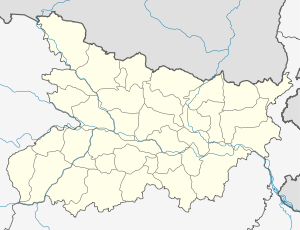Buxar
| Buxar | |
|---|---|
| City | |
 Buxar Location in Bihar, India | |
| Coordinates: 25°33′38″N 83°58′50″E / 25.56049°N 83.98054°ECoordinates: 25°33′38″N 83°58′50″E / 25.56049°N 83.98054°E | |
| Country |
|
| State | Bihar |
| District | Buxar |
| Area | |
| • Total | 1,620 km2 (630 sq mi) |
| Elevation | 55 m (180 ft) |
| Population (2011) | |
| • Total | 102,861 |
| • Density | 63/km2 (160/sq mi) |
| Languages | |
| • Official | Hindi |
| Time zone | UTC+5:30 (IST) |
| PIN | 802101 |
| Telephone code | 06183 |
| Vehicle registration | BR-44 |
| Website |
buxar |
Buxar is a city in the state of Bihar in the eastern part of India bordering eastern Uttar Pradesh. It is the headquarters of Buxar District. The Battle of Buxar and Battle of Chausa were fought in the vicinity.[1][2][3] Buxar Railway Station lies on Patna–Mughalsarai section of Howrah–Delhi main line. It is approximately 125 km from the state capital of Patna. The local language of Buxar is Bhojpuri.
Demography
As of 2011 India census,[4] Buxar had a population of 102,861. Males constitute 52.65% of the population and females 47.35%. Buxar has an average literacy rate of 79.77%, higher than the national average of 59.5%; with male literacy of 87% and female literacy of 65%. 16% of the population is under 6 years of age.
Geography Buxar district occupies an area of 1,703 square kilometres (658 sq mi), comparatively equivalent to Australia's Bathurst Island.
Mythology It is said that Ahilya, the wife of Gautam Rishi restored her human body from that of stone and got salvation by a mere touch of the feet of Lord Rama. This place is now known as Ahirauli, and is situated six kilometers away from Buxar.
Battle of Buxar The Battle of Buxar was fought on 22 October 1764 between the forces under the command of the British East India Companyled by Hector Munro and the combined armies of Mir Qasim, the Nawab of Bengal; the Nawab of Awadh; and the Mughal Emperor Shah Alam II.[4] The battle fought at Buxar, a "small fortified town" within the territory of Bengal, located on the banks of the Ganges river about 130 kilometres (81 mi) west of Patna, was a decisive victory for the British East India Company.
Chhath The Chhath Puja is dedicated to the Sun and his wife Usha in order to thank them for bestowing the bounties of life on earth and to request the granting of certain wishes. The Jeet, considered as the god of energy and of the life-force, is worshiped during the Chhath festival to promote well-being, prosperity and progress. In Hinduism, Sun worship is believed to ensure the longevity and prosperity of family members, friends, and elders.
| Historical populations | ||
|---|---|---|
| Year | Pop. | ±% |
| 1911 | 11,309 | — |
| 1921 | 10,098 | −10.7% |
| 1931 | 13,449 | +33.2% |
| 1941 | 14,879 | +10.6% |
| 1951 | 18,087 | +21.6% |
| 1961 | 23,068 | +27.5% |
| 1971 | 31,691 | +37.4% |
| 1981 | 42,952 | +35.5% |
| 1991 | 55,753 | +29.8% |
| 2001 | 83,168 | +49.2% |
| 2011 | 102,861 | +23.7% |
| "District Census Handbook Part A - Buxar" (PDF). Census of India. p. 731. | ||
See also
References
| Wikisource has the text of the 1911 Encyclopædia Britannica article Buxar. |
- ↑ "Archived copy". Archived from the original on 12 March 2017. Retrieved 11 March 2017.
- ↑ "Archived copy". Archived from the original on 12 March 2017. Retrieved 11 March 2017.
- ↑ https://www.telegraphindia.com/1151027/jsp/bihar/story_49751.jsp#.WMNcKfnyuM8 Archived 12 March 2017 at the Wayback Machine.
- ↑ "Census of Buxar". Census of India. Archived from the original on 11 December 2013. Retrieved 9 December 2013.